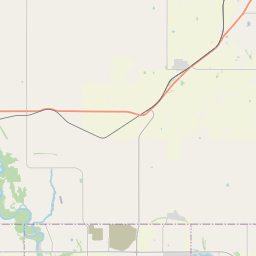Lewis and Clark Campsite
Historical marker location:
Fort Calhoun, Nebraska
( Marker can be reached from Madison St, 0.6 miles east of U.S. 75.)







© OpenStreetMap contributors
July 30 - August 2, 1804
A brief timeline of the Lewis and Clark Expedition
- 1803: President Thomas Jefferson commissions Meriwether Lewis, his personal secretary, to lead an expedition to explore the western territories of the United States and find a practical route to the Pacific Ocean.
- 1804: Lewis meets up with William Clark, a former army officer and experienced explorer, in Kentucky. They assemble a team of over 30 men and set out on the journey up the Missouri River.
- 1805: The expedition reaches the Rocky Mountains and crosses the Continental Divide. They build Fort Clatsop on the Pacific coast and spend the winter there, before returning east in the spring of 1806.
- 1806: Lewis and Clark split up to explore different routes on their way back to St. Louis. They reunite in September and return to civilization, where they are celebrated as national heroes.
- 1807: The Lewis and Clark Expedition publishes an official account of their journey, called the "History of the Expedition Under the Command of Captains Lewis and Clark," which becomes a bestseller and helps to promote westward expansion.
Loading...
Searching for other points of interest within 3 miles of this location.Nebraska was originally part of the Louisiana Purchase, which was a vast territory acquired by the United States from France in 1803.
About Washington County
Washington County Timeline
Washington County, NE has a rich and diverse history that dates back to the early 1800s. Its story begins with the arrival of European settlers in the area, primarily consisting of German immigrants looking for fertile land to establish farms and build communities. In 1854, the county was officially organized and named after George Washington, the first President of the United States.
The establishment of Washington County was closely tied to the growth of agriculture in the region. These hardworking settlers transformed the prairie landscape into productive farmland, cultivating crops such as corn, wheat, and oats. The introduction of the railroad in the late 1800s further stimulated economic development, allowing for the transportation of goods and attracting additional settlers to the county.
Over the years, Washington County experienced various challenges and triumphs. In the late 19th century, floods caused by the nearby Missouri River posed significant threats to the communities along its banks. However, the resilience of the residents and efforts to construct levees and flood control measures helped mitigate the damage caused by these natural disasters.
In the 20th century, Washington County continued to evolve with the changing times. The construction of highways and bridges enhanced connectivity within the county and facilitated economic growth. The county remains an agricultural stronghold, with many farm families passing down their traditions and skills from generation to generation. Additionally, the county has embraced modern advancements, including technology and manufacturing, contributing to its overall prosperity.
Today, Washington County thrives as a vibrant and close-knit community, with a strong emphasis on preserving its cultural heritage and promoting economic growth. The county celebrates its history through various events, festivals, and local museums, providing residents and visitors alike with a deeper understanding of its past and the important role it plays in Nebraska history.
The establishment of Washington County was closely tied to the growth of agriculture in the region. These hardworking settlers transformed the prairie landscape into productive farmland, cultivating crops such as corn, wheat, and oats. The introduction of the railroad in the late 1800s further stimulated economic development, allowing for the transportation of goods and attracting additional settlers to the county.
Over the years, Washington County experienced various challenges and triumphs. In the late 19th century, floods caused by the nearby Missouri River posed significant threats to the communities along its banks. However, the resilience of the residents and efforts to construct levees and flood control measures helped mitigate the damage caused by these natural disasters.
In the 20th century, Washington County continued to evolve with the changing times. The construction of highways and bridges enhanced connectivity within the county and facilitated economic growth. The county remains an agricultural stronghold, with many farm families passing down their traditions and skills from generation to generation. Additionally, the county has embraced modern advancements, including technology and manufacturing, contributing to its overall prosperity.
Today, Washington County thrives as a vibrant and close-knit community, with a strong emphasis on preserving its cultural heritage and promoting economic growth. The county celebrates its history through various events, festivals, and local museums, providing residents and visitors alike with a deeper understanding of its past and the important role it plays in Nebraska history.
Washington County Timeline
This timeline provides a concise overview of the key events in the history of Washington County, Nebraska.
- 1854 - Washington County, NE was officially organized as a county.
- 1858 - The county seat, Blair, was established.
- 1864 - The first newspaper in the county, the Washington County Sentinel, was published.
- 1871 - The Omaha and Northwestern Railroad was completed, connecting Blair to Omaha.
- 1877 - The First National Bank of Blair was established, becoming the first bank in the county.
- 1902 - A devastating tornado swept through Blair, causing extensive damage.
- 1919 - The Washington County Historical Association was formed to preserve the county's history.
- 1933 - The Blair Municipal Pool, one of the first public swimming pools in the state, was opened.
- 1969 - Dana College, a private liberal arts college, was founded in Blair.
- 2000 - The Blair Bridge, a historic truss bridge, was added to the National Register of Historic Places.
- 2010 - The population of Washington County reached over 20,000 residents.